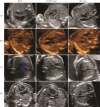Why are congenital heart defects being missed?
- PMID: 31131945
- PMCID: PMC7317409
- DOI: 10.1002/uog.20358
Why are congenital heart defects being missed?
Abstract
Objective: Congenital heart defects (CHD) are still missed frequently in prenatal screening programs, which can result in severe morbidity or even death. The aim of this study was to evaluate the quality of fetal heart images, obtained during the second-trimester standard anomaly scan (SAS) in cases of CHD, to explore factors associated with a missed prenatal diagnosis.
Methods: In this case-control study, all cases of a fetus born with isolated severe CHD in the Northwestern region of The Netherlands, between 2015 and 2016, were extracted from the PRECOR registry. Severe CHD was defined as need for surgical repair in the first year postpartum. Each cardiac view (four-chamber view (4CV), three-vessel (3V) view and left and right ventricular outflow tract (LVOT, RVOT) views) obtained during the SAS was scored for technical correctness on a scale of 0 to 5 by two fetal echocardiography experts, blinded to the diagnosis of CHD and whether it was detected prenatally. Quality parameters of the cardiac examination were compared between cases in which CHD was detected and those in which it was missed on the SAS. Regression analysis was used to assess the association of sonographer experience and of screening-center experience with the cardiac examination quality score.
Results: A total of 114 cases of isolated severe CHD at birth were analyzed, of which 58 (50.9%) were missed and 56 (49.1%) were detected on the SAS. The defects comprised transposition of the great arteries (17%), aortic coarctation (16%), tetralogy of Fallot (10%), atrioventricular septal defect (6%), aortic valve stenosis (5%), ventricular septal defect (18%) and other defects (28%). No differences were found in fetal position, obstetric history, maternal age or body mass index (BMI) or gestational age at examination between missed and detected cases. Ninety-two cases had available cardiac images from the SAS. Compared with the detected group, the missed group had significantly lower cardiac examination quality scores (adequate score (≥ 12) in 32% vs 64%; P = 0.002), rate of proper use of magnification (58% vs 84%; P = 0.01) and quality scores for each individual cardiac plane (4CV (2.7 vs 3.9; P < 0.001), 3V view (3.0 vs 3.8; P = 0.02), LVOT view (1.9 vs 3.3; P < 0.001) and RVOT view (1.9 vs 3.3; P < 0.001)). In 49% of missed cases, the lack of detection was due to poor adaptational skills resulting in inadequate images in which the CHD was not clearly visible; in 31%, the images showed an abnormality (mainly septal defects and aortic arch anomalies) which had not been recognized at the time of the scan; and, in 20%, the cardiac planes had been obtained properly but showed normal anatomy. Multivariate regression analysis showed that the volume of SAS performed per year by each sonographer was associated significantly with quality score of the cardiac examination.
Conclusions: A lack of adaptational skills when performing the SAS, as opposed to circumstantial factors such as BMI or fetal position, appears to play an important role in failure to detect CHD prenatally. The quality of the cardiac views was inadequate significantly more often in undetected compared with detected cases. Despite adequate quality of the images, CHD was not recognized in 31% of cases. A high volume of SAS performed by each sonographer in a large ultrasound center contributes significantly to prenatal detection. In 20% of undetected cases, CHD was not visible even though the quality of the images was good. © 2019 Authors. Ultrasound in Obstetrics & Gynecology published by John Wiley & Sons Ltd on behalf of International Society of Ultrasound in Obstetrics and Gynecology.
Keywords: audit; congenital heart defects; false negative; prenatal diagnosis; risk factors; screening; ultrasound.
© 2019 Authors. Ultrasound in Obstetrics & Gynecology published by John Wiley & Sons Ltd on behalf of International Society of Ultrasound in Obstetrics and Gynecology.
Figures



Comment in
-
Fetal cardiac evaluation services for low-risk pregnancies: how can we improve?Ultrasound Obstet Gynecol. 2020 Jun;55(6):726-727. doi: 10.1002/uog.22052. Ultrasound Obstet Gynecol. 2020. PMID: 32478982
References
-
- Calderon J, Angeard N, Moutier S, Plumet MH, Jambaque I, Bonnet D. Impact of prenatal diagnosis on neurocognitive outcomes in children with transposition of the great arteries. J Pediatr 2012; 161: e1.94–98. - PubMed
-
- Chakraborty A, Gorla SR, Swaminathan S. Impact of prenatal diagnosis of complex congenital heart disease on neonatal and infant morbidity and mortality. Prenat Diagn 2018; 38: 958–963. - PubMed
-
- Quartermain MD, Hill KD, Goldberg DJ, Jacobs JP, Jacobs ML, Pasquali SK, Verghese GR, Wallace AS, Ungerleider RM. Prenatal Diagnosis Influences Preoperative Status in Neonates with Congenital Heart Disease: An Analysis of the Society of Thoracic Surgeons Congenital Heart Surgery Database. Pediatr Cardiol 2019; 40: 489–496. - PubMed
-
- Thakur V, Dutil N, Schwartz SM, Jaeggi E. Impact of prenatal diagnosis on the management and early outcome of critical duct‐dependent cardiac lesions. Cardiol Young 2018; 28: 548–553. - PubMed
Publication types
MeSH terms
LinkOut - more resources
Full Text Sources
Other Literature Sources
Medical

